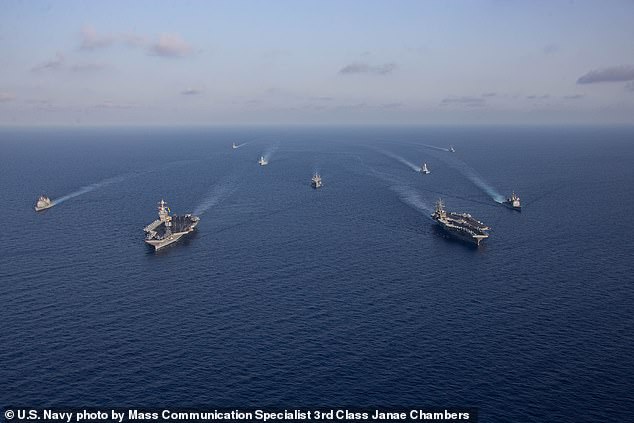
In the midst of maritime tensions, the USS Thomas Hudner, an Arleigh Burke-class guided-missile destroyer, found itself confronting an unwelcome visitor in the form of a drone launched from Yemen. The incident occurred as the ship patrolled the Red Sea, a vital waterway frequented by vessels of various nations.
According to a Pentagon official, the crew of the Hudner promptly responded to the drone’s approach, taking action to neutralize the threat and safeguard the ship and its personnel. Fortunately, no casualties or damage to the vessel were reported, a testament to the crew’s vigilance and expertise in handling such situations.
The origin and intent of the drone remain shrouded in uncertainty. While it emerged from Yemeni territory, whether it was armed and how close it came to the ship before being intercepted remain unanswered questions.
This encounter forms part of a broader context of escalating tensions in the region. Iran-backed proxy militias, operating in Iraq and Syria, have been increasingly active, targeting US forces in retaliation for perceived support to Israel in its conflict with Hamas.
In Yemen, the Houthi rebels, supported by Iran, have been engaged in a protracted conflict against a Saudi-led coalition since 2015. Over the years, they have transformed into a formidable military force, possessing a substantial arsenal of ballistic missiles and drones.
This incident is not an isolated one. In recent times, there have been multiple instances of US warships intercepting hostile projectiles launched by militant groups in the region. Last month alone, another US vessel thwarted a barrage of cruise missiles and drones launched from Yemen towards Israel.
The Houthis, emboldened by their military capabilities, have made their intentions clear. They have openly declared their intent to continue attacks, even hinting at targeting Israeli vessels in strategic waterways like the Red Sea and the Bab al-Mandeb Strait.
Adding to the complexity is the downing of a US military drone by Houthi forces in international airspace just a week prior to this incident. Such actions have prompted the United States to bolster its naval presence in the Middle East, deploying additional assets including aircraft carrier strike groups and troops.
Meanwhile, tensions on land have also been escalating. US and coalition forces in Iraq and Syria have faced numerous missile and drone attacks, resulting in injuries but thankfully no fatalities. The perpetrators of these assaults, often linked to Iran-backed militias, justify their actions as responses to perceived American support for Israel.
In response to these threats, the United States has not hesitated to take decisive action. Multiple sets of airstrikes have been conducted against Iran-linked militia targets in Syria, aimed at degrading their capabilities and deterring further aggression.
Defense Secretary Lloyd Austin has reiterated the US commitment to protecting its personnel and interests in the region, emphasizing the authorization given by President Joe Biden for these defensive measures.
As tensions continue to simmer, there are growing concerns about the potential for the Israel-Hamas conflict to escalate into a wider regional crisis, posing significant risks to stability and the safety of all involved. The situation remains fluid, with diplomatic efforts alongside military preparedness playing crucial roles in managing and, hopefully, de-escalating the situation.
RELATED ARTICLES
- Russia Hits Ukrainian Apartment Blocks with Drones in Odesa, Killing 7 including Mother and 2 Babies
- US War with Yemen Houthis Intensifies in the Red Sea
- UK Threatens War on Yemen's Houthis
- Houthis Getting Ready to send 20K Troops to Gaza
- US Warship Shoots Down 14 Yemeni Drones in Red Sea











